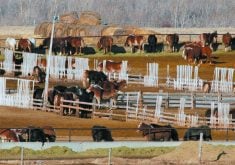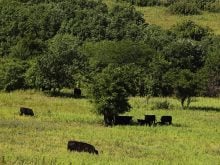I’m often asked if there is one vaccine preferred or better than other vaccines. My usual response is that it is difficult to compare vaccines because we rarely have enough good research to prove whether there are significant differences between vaccines.
Such studies are difficult and expensive to perform and often we are pleased if there are good clinical trials that prove a specific vaccine is effective compared to a placebo (nothing), let alone compared to other vaccines. However, these kinds of questions are important and deserve consideration.
Read Also

Feds propose overhaul of chronic wasting disease control program
Chronic Wasting disease control program getting updated by Canadian Food Inspection Agency with feedback encouraged from producers.
A recent publication in the Canadian Veterinary Journal examined this type of question by looking at the effect of vaccine administration method on the protection of calves at different ages against bovine coronavirus in weaning age beef cattle.
Bovine coronavirus has been associated with respiratory disease in cattle and although we often think of it as a cause of scours, there is growing evidence that it plays a role in respiratory disease in calves, especially at weaning. One previous study demonstrated that vaccinating calves at arrival to the feedlot with an intranasal vaccine reduced the need for BRD treatments.
This new study was conducted by Dr. Nathan Erickson and Dr. John Ellis and other colleagues at the Western College of Veterinary Medicine. In this study, they used vaccines produced by one company (Zoetis) but examined how the route of administration changed the antibody response in the calves.
In the first of two studies, they randomized calves at birth to receive one of four groups. One group received no vaccines at birth, turn-out and pre-weaning (the control group). Another group received the modified live vaccine for rotavirus and coronavirus (Calfguard) intramuscularly at all three timepoints. The third group received the same vaccine intranasally at all three timepoints and the fourth group received the vaccine intranasally at birth and then intramuscularly at turn-out and pre-weaning.
Blood samples were collected several times to evaluate the antibody responses to these vaccines. It should be noted that this vaccine is licensed for oral or intramuscular use, and the intra-nasal use is considered an off-label application.
The antibody levels at weaning were highest in calves that received the vaccine intranasally at birth followed by intramuscular administration at turn-out and weaning. This result confirms previous studies using other vaccines for infectious bovine rhinotracheitis that an initial intranasal vaccine followed by an injectable booster improved immune responses in calves and gave better protection against disease.
In a second study, the same researchers gave all calves the intranasal vaccine at birth. At turnout (approximately 42 days of age), the calves were given either an intramuscular injection of an inactivated vaccine (Scourguard) or an intramuscular injection of the same modified live vaccine (Calfguard). The calves were then given another intramuscular injection of the same vaccine they received at turnout prior to weaning.
In this study, both groups of calves had a similar memory response of antibodies post weaning regardless of whether they received a killed or modified live vaccine as their booster injection at turnout and pre-weaning.
These types of studies are difficult to perform, but they provide valuable information, and we need more research like this to inform our vaccine recommendations. These results build on other studies that demonstrate that when vaccinating very young calves, the antibody responses seem to be improved by using an intranasal vaccine initially and then following up with systemic vaccines as the booster doses.
The authors caution that the sample sizes of these studies were limited and that the relationship between the level of antibodies present in the calf at the time of initial vaccination could not be evaluated adequately to determine their effect on the calf’s response to the vaccines.
The antibodies received by the calf from the dam through colostrum may have an impact on the calf’s ability to respond to various vaccines, and this effect may also be specific for various viruses. For coronavirus, the intranasal vaccine as the primer vaccination at birth, followed by injectable vaccines as boosters, gave the best immune response.
Vaccine protocols are complicated and must be adapted to the herd’s risk factors and management.
John Campbell is a professor in the department of Large Animal Clinical Sciences at the University of Saskatchewan’s Western College of Veterinary Medicine.















